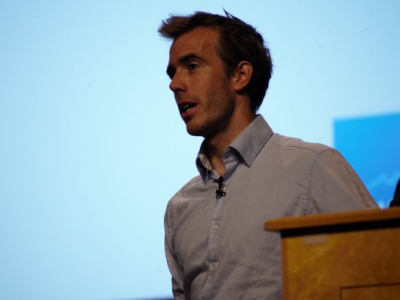
At the PMG Conference 2018 in Manchester, James Hollington from the Southeast Mobility and Rehabilitation Technology (SMART) Centre in Edinburgh presented on the topic Using foam carve seating with anterior contouring for clients who rotate out of their lateral support. James (pictured right) described two complex case studies to illustrate the successful use and potential value of anterior supports in customised seating. He had found that such supports were worth clinical consideration in cases where:
- clients presented with complex posture and required a full foam carve
- clients were corkscrewing bilaterally, flexing their spine and rotating their torso out of their seating system
- clients were without functional ability in their upper limbs
- tilt and harnesses (including Y harnesses) were not sufficient for anterior anchorage and prevention of rotation from the shoulder
- all other feasible routes of seating had been explored first
In these cases, he found that anterior supports could be used to help clients achieve an optimal seated position. This process is a labour intensive one, requiring two casting bags and often presenting difficulties with scanning and processing. Such processing difficulties include the strength of the support (one arm alone equals 5.3% of total body weight) and configuration of the support e.g. the way in which forces and weight can be integrated into the design to allow for functional operation of the catch required for hinging the new support. Specifically, it was found that forces in line with one another (i.e. those in perpendicular position) allow for better lateral catch release.
Additionally, it was important to ensure that the interface of the anterior lateral support to back rest was positioned posteriorly to the rib cage apex and shoulder to prevent any gap emerging between segments that the client could slip into. This particular interface configuration is also preferable because it allows for a shelf to be created under the flexed spine which can introduce some useful upward force and lift to protect against further scoliosis.
Engineering challenges aside, the importance of identifying risks to the client were also stated, such as impact on breathing and/or shoulder joint.
In terms of the risk to breathing, pre-existing conditions and challenges should be considered but, where benefits are felt to outweigh concerns, it is suggested that clients might trial the impact of anterior support on breathing by spending a prolonged period in the casting bags. Over this extended period any vital signs may be monitored.
Strain on the shoulder joint may be mediated by carving a gutter/shelf and enabling access to additional upper limb therapy. Heat may be managed by choice of material (such as spacer and/or bamboo covers), incorporation of airflow holes, and provision of education to users/support staff regarding 24-hour postural management and appropriate choice of clothing.
If all outlined risks and design considerations are subject to stringent clinical reasoning, James demonstrated how anterior supports could have a positive impact on service users’ quality of life. For some of the case studies presented this included:
- increased comfort, outcome measured by a decrease in challenging behaviour, and
- a decrease in pulmonary aspiration (from three times a month to none)
These outcomes were measured using the Goal Attainment Scaling (GAS) format.
All of the above will be useful knowledge when referring my own complex clients from special education to their respective wheelchair services. If students are corkscrewing out of their old (or even new) moulded seating systems, I can make a referral and provide practical, solution-focused input. When clinicians or engineers are still left scratching their heads, I can refer them to the SMART centre work to see exactly how it can be done!
Yes, it’s true there may be a few other things I may wish to consider - such as how will a student now travel in transport without a harness? Can I have a cutaway for a seat belt carved into the foam or has this been risk assessed as reasonable? Also, what is the impact of the anterior support from a sensory perspective? Are there effects of tonic pull and stimulation of key points that could be of relevance?
I guess the answer is that every case is different but, if we consider all of the above, we may have a good chance of successfully seating some of the most complex clients in our caseloads.
Thank you James Hollington and your SMART centre colleagues for sharing your findings and expertise. I will most certainly be storing this new-found knowledge in my OT tool box for a later date!
Photography by Jonathan Rourke






.jpg)



no comments
Add your comment...